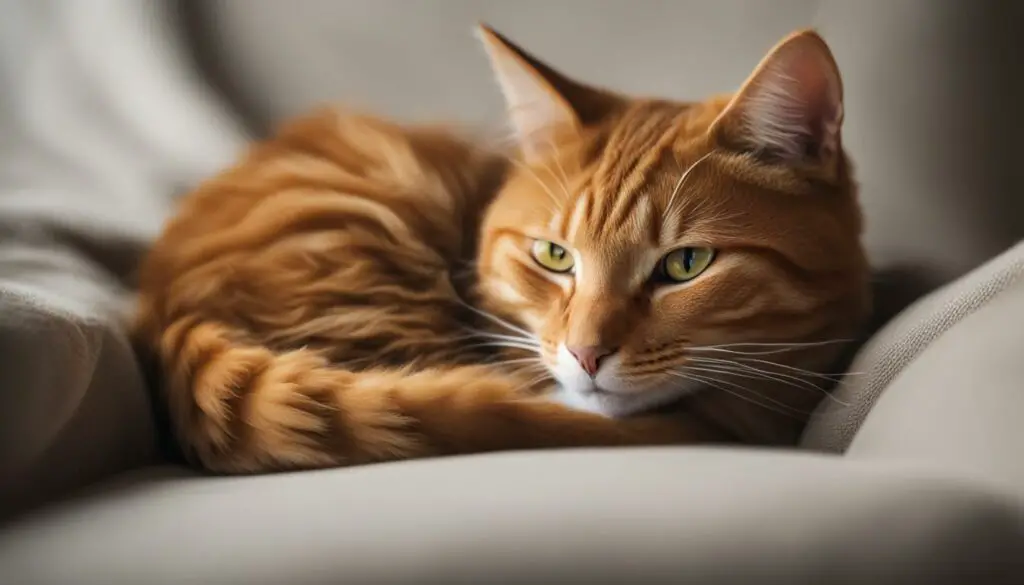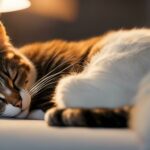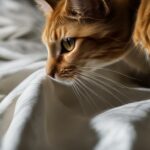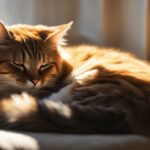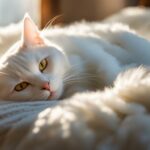Cats are fascinating creatures with unique behaviors and body language that can sometimes leave us puzzled. One intriguing sleeping position that many cat owners have observed is the “cat loafing with head down” pose. This position involves a cat sitting with its body curled up, head down, and possibly resting on its paws. While it may seem strange, there are several reasons behind this behavior.
Key Takeaways:
- Cats adopt the “cat loafing with head down” position for various reasons, including comfort and security during sleep.
- It may also be a way for cats to block out light and create a darker sleeping environment.
- Some cats simply find this position to be the most comfortable one for them, reflecting their individual sleeping preferences.
- However, if you notice any changes in your cat’s sleeping behavior or suspect health issues, it’s essential to consult with a veterinarian for further evaluation.
- Creating a comfortable sleeping environment for your cat, with cozy bedding and a warm, dark space, can help promote better sleep and reduce the need for unusual sleeping positions.
Why Is Your Cat Sleeping Face Down?
Cats are fascinating creatures, and their sleeping positions can be quite perplexing. One common position that cats adopt is sleeping face down. But why do they do this? There are several possible reasons behind this peculiar sleeping habit.
Comfort and Relaxation
Sleeping face down may simply be a comfortable position for your cat. Cats have individual preferences when it comes to sleep, and some find this position to be the most relaxing. It allows them to rest their bodies fully and sink into a deep slumber. Just like humans have their preferred sleeping positions, cats do too.
Feeling Safe and Protected
Cats are instinctually cautious and always aware of potential threats in their environment. Sleeping face down may be a way for them to feel safe and protected. By tucking their heads and curling their bodies, they can create a sense of security while they sleep. This position allows them to keep their vulnerable parts, such as their stomach and vital organs, protected from any potential dangers.
Blocking Out Light and Staying Warm
Another reason why cats may sleep face down is to block out light and keep their noses warm. Cats have highly sensitive eyes, and bright lights can disturb their sleep. By sleeping with their faces on the ground, they can shield their eyes from any excessive light and create a darker sleeping environment. Additionally, this position allows them to keep their noses cozy and warm, as they often burrow their heads into their paws or bedding.
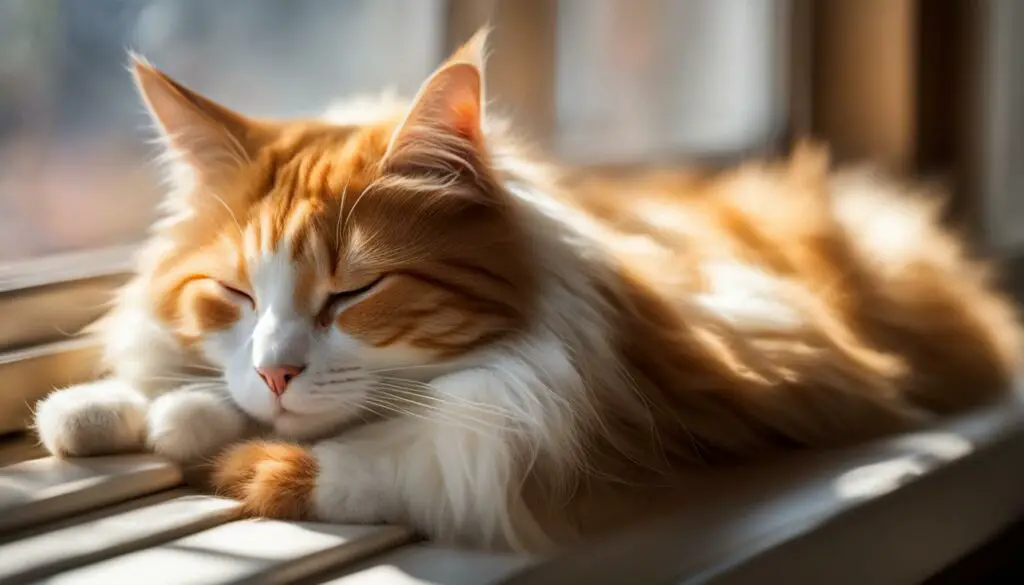
| Reasons Why Cats Sleep Face Down | Explanation |
|---|---|
| Comfort | Sleeping face down is a comfortable position for some cats. |
| Feeling Safe | This position allows cats to feel safe and protected while sleeping. |
| Blocking Out Light | Sleeping face down helps cats create a darker sleeping environment by shielding their eyes from bright lights. |
| Staying Warm | By burying their heads or noses, cats can keep their noses warm and cozy while they sleep. |
Understanding why your cat chooses to sleep face down can help you create a comfortable and inviting sleeping environment for them. Providing a cozy bed, ensuring a dimly lit space, and keeping the area warm can all contribute to better quality sleep for your feline friend.
Cat Sensitivity to Light: Understanding Their Vision and Sleeping Habits
As cat owners, we may have noticed that our feline friends often seek out dark and cozy spots to nap or sleep. This behavior can be attributed to their sensitivity to light and their unique vision. Cats have eyes that are six times more sensitive to light than human eyes, allowing them to navigate in low-light conditions and see clearly in the dark. However, this sensitivity to light can also affect their sleeping patterns.
When it is too bright, cats may struggle to find a comfortable sleeping position. To block out the excess light and create a darker sleeping environment, cats may choose to sleep with their heads down, possibly resting on their paws. This position allows them to partially cover their faces and eyes, reducing the amount of light that reaches their sensitive retinas. By blocking out the light, cats can create a more conducive environment for peaceful and uninterrupted sleep.
It’s important to note that this behavior is particularly significant for cats who have a natural instinct for hunting at night. As nocturnal creatures, they rely on darkness to be more alert and efficient hunters. By sleeping with their heads down, cats are able to mimic the hunting posture, preparing themselves for potential prey while ensuring a good night’s rest.
| Advantages of Cat Sleeping with Head Down | Disadvantages of Cat Sleeping with Head Down |
|---|---|
|
|
“Cats have a natural instinct to seek out dark and quiet places to sleep. By sleeping with their heads down, they can create a mini sanctuary where they feel safe and can get the rest they need.”
Creating a Cat-Friendly Sleeping Environment
To ensure your cat gets the best sleep possible, it’s essential to provide them with a comfortable sleeping area that addresses their sensitivity to light. Consider creating a designated sleep space that is warm, dark, and cozy. You can achieve this by:
- Placing the bed or sleeping area in a quiet corner or secluded spot
- Using curtains or blinds to regulate natural light during the day
- Providing a soft and supportive bed or cushion for your cat to sleep on
By creating a cat-friendly sleeping environment, you can help your furry friend enjoy restful sleep, whether they choose to sleep with their heads down or in any other preferred position.
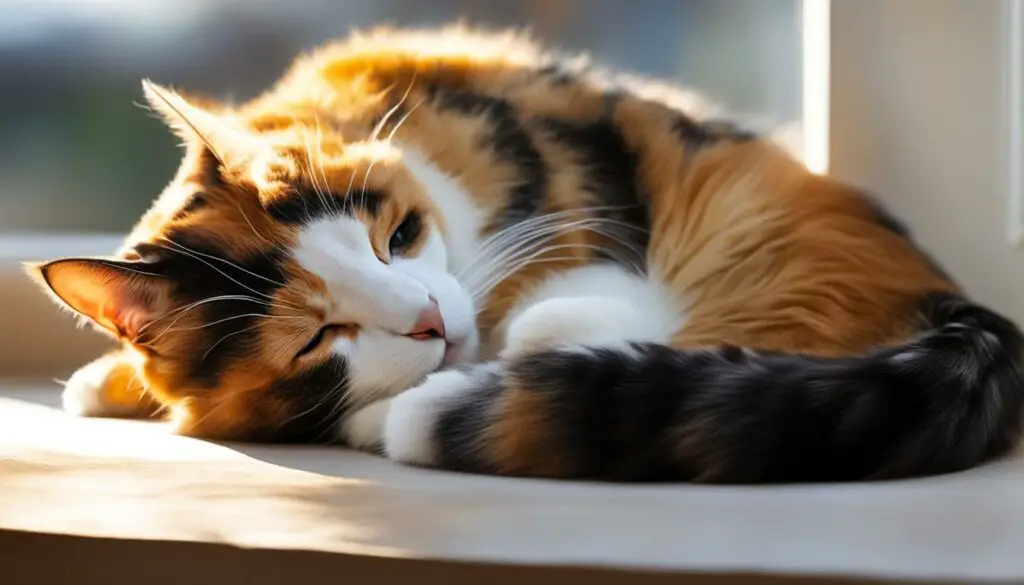
Table: Advantages and Disadvantages of Cat Sleeping with Head Down. This table highlights the benefits and potential drawbacks of cats sleeping with their heads down. While this position helps block out excess light and creates a darker sleeping environment, it may cause discomfort if not properly supported or can lead to neck or back strain in some cats. It’s important to provide a comfortable and supportive sleeping area to mitigate any potential disadvantages.
Your Cat’s Nose Is Feeling Cold
When your cat sleeps with its head down, it may be trying to keep its nose warm. Cats have a higher body temperature than humans and rely on external heat sources to regulate their body temperature. By burying their nose in their paws or bedding, cats can create a warm and cozy environment for themselves. This position helps them stay comfortable while they sleep and ensures that their sensitive noses don’t get too cold.
To better understand why cats sleep with their heads down, it’s important to consider their natural body temperature. Unlike humans, cats have a normal body temperature ranging from 100.5 to 102.5 degrees Fahrenheit. They can lose body heat rapidly, especially through their exposed extremities. By tucking their head down, cats can conserve heat and maintain their body temperature, keeping their cozy sleeping position.
It’s fascinating how cats instinctively know how to regulate their body temperature. By sleeping with their heads down, they are utilizing their body’s natural heat sources to keep warm. This behavior is especially prevalent in cooler environments or during colder seasons when cats need extra warmth. So, next time you spot your cat in this position, know that they are simply using their paws and their surroundings to stay cozy while they slumber.
| Benefits of Sleeping with Head Down | Contributes to a warm and cozy sleep environment | Helps cats maintain their body temperature | Prevents their sensitive noses from becoming cold |
|---|---|---|---|
| Reasons for Sleeping with Head Down | Regulating body heat | Feeling safe and secure | Seeking warmth and comfort |
Remember, every cat is unique, and their sleeping positions can vary. Some cats may prefer sleeping with their heads down, while others may have different preferences. As a responsible cat owner, it is essential to provide a comfortable sleeping environment for your furry friend. Ensure that they have warm bedding, a cozy spot, and a peaceful atmosphere. By understanding your cat’s behaviors and needs, you can help them have a restful and rejuvenating sleep.
Your Cat’s Sleeping Preferences: Comfort, Behavior, and More
Understanding your cat’s sleeping preferences can provide valuable insights into their comfort, behavior, and overall well-being. Cats, like humans, have unique preferences when it comes to their sleep, and each position they choose to sleep in serves a specific purpose. From curled up positions to stretched out poses, here’s a closer look at some common cat sleeping positions and what they may indicate:
Curled Up in a Ball
One of the most common sleeping positions for cats is curling up in a ball. This position allows cats to conserve body heat, protect their vital organs, and feel secure. When cats curl up in a ball, they create a cozy and safe spot for themselves, ensuring a restful sleep. It’s their way of finding comfort and warmth in their sleeping environment.
Stretched Out and Relaxed
Sometimes, you may find your cat stretched out on its side, legs fully extended, and appearing completely relaxed. This position indicates that your cat feels completely at ease and comfortable in its surroundings. When cats sleep in this manner, it shows that they trust their environment and feel safe enough to let their guard down.
Curled Up with Paws Tucked Under
Another popular sleeping position for cats is curling up with their paws tucked under their body. This position not only helps cats retain body heat but also allows them to easily transition from sleeping to an alert state. By keeping their paws close to their body, cats can quickly and effortlessly get up and be ready for any potential threats or opportunities that may arise.
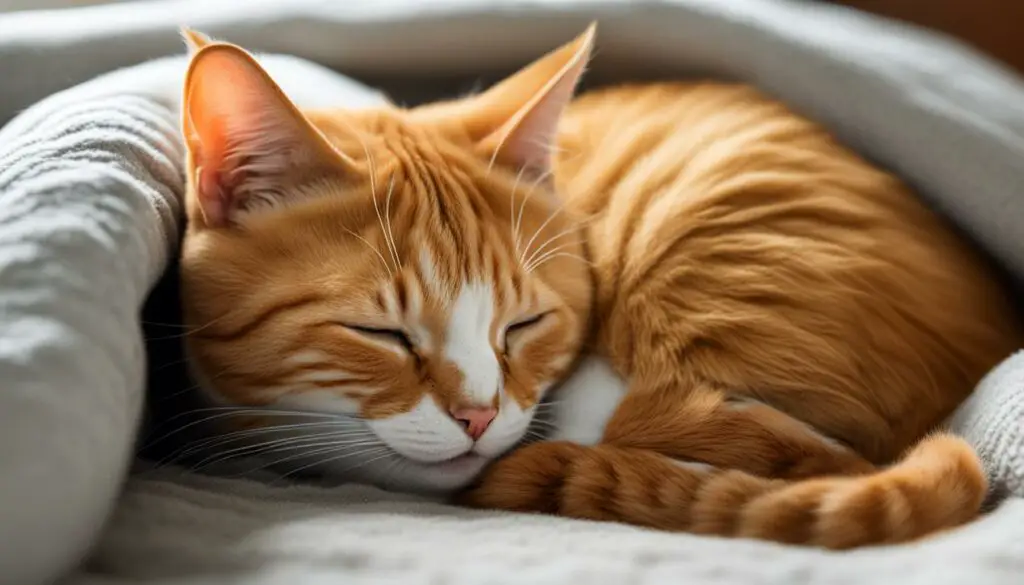
It’s important to note that each cat is unique, and their sleeping preferences may vary. Some cats may prefer sleeping in high perches or cozy cat beds, while others may enjoy sprawling out across the floor. By observing your cat’s sleeping positions and understanding their preferences, you can create a comfortable and safe sleeping environment that meets their needs.
Your Cat Is Exhausted
After a long play session or a busy day, your cat may become exhausted and need a good rest. Just like humans, cats need sufficient sleep to recharge their energy levels. When a cat is extremely tired, it may choose to sleep face down as a way to quickly fall into a deep and restful sleep.
Sleeping face down allows the cat to fully relax and unwind. It’s a position that helps them feel secure and comfortable, promoting a more restorative sleep. Cats may also choose to sleep face down when they are feeling worn out and need uninterrupted rest to rejuvenate.
It’s important to note that while occasional exhaustion is normal, consistently excessive sleepiness or lethargy can be a sign of an underlying health issue. It’s crucial to monitor your cat’s sleep patterns and overall behavior to ensure they are not excessively tired or displaying any other concerning symptoms.
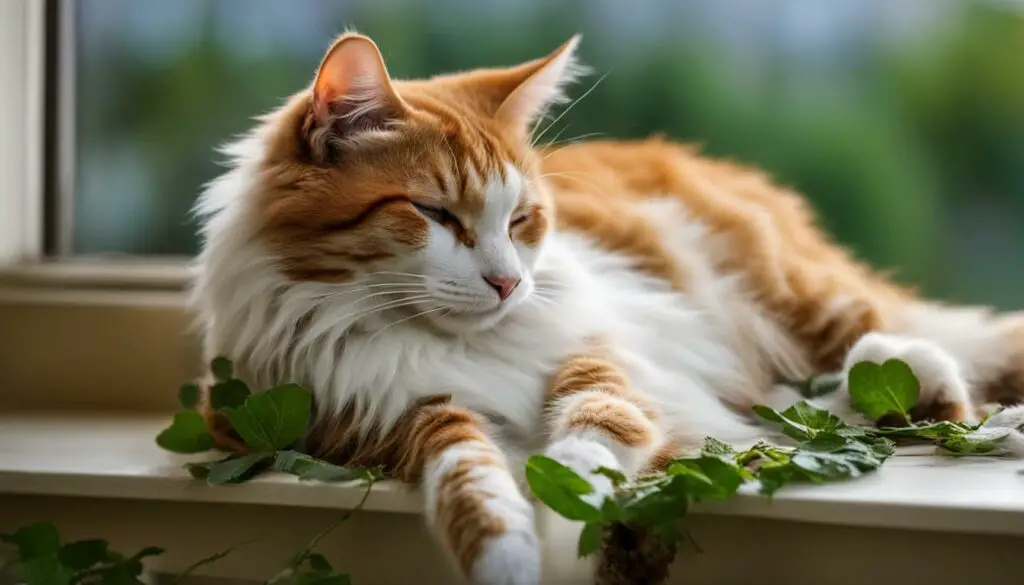
If you have concerns about your cat’s sleep patterns or overall well-being, it’s always a good idea to consult with a veterinarian. They can provide further guidance and perform any necessary examinations to rule out any potential health issues.
Section 7: Your Cat Might Have Health Issues
If you notice your cat consistently sleeping in the “cat loafing with head down” position, it may be worth considering if there are any underlying health issues. This sleeping position can be particularly common in older cats who may suffer from arthritis or joint pain. Arthritis can make it uncomfortable for cats to sleep in other positions, so they may prefer the head-down pose as it offers them some relief. It’s important to observe your cat’s overall behavior and movement to determine if there are any other signs of discomfort or mobility issues.
Table: Common Health Issues that may be associated with Cat Sleeping Positions
| Health Issue | Description |
|---|---|
| Arthritis | A condition that causes inflammation and pain in the joints, often affecting older cats. |
| Joint Pain | Pain or discomfort in the joints, potentially caused by injury or other underlying health conditions. |
If you suspect that your cat may be experiencing joint pain or other health issues, it is recommended to consult with a veterinarian. They can conduct a thorough examination and provide appropriate treatment options to alleviate your cat’s discomfort. Additionally, your vet may recommend supplements or medications to help manage any pain or inflammation your cat may be experiencing.
Remember, while sleeping with the head down can be a normal sleeping position for cats, it’s always important to monitor any changes in your cat’s behavior and seek veterinary advice if you have any concerns about their health or well-being.
Does Your Cat Have A Comfortable Sleeping Area?
Creating a comfortable sleeping environment for your cat is essential to ensure they get quality rest. Here are some factors to consider for your cat’s sleeping area:
Location:
Choose a quiet and peaceful area of your home for your cat’s sleeping spot. Avoid places with high foot traffic or noisy appliances that may disturb their sleep.
Temperature:
Cats prefer warm environments, so make sure their sleeping area is cozy and at a comfortable temperature. Consider providing a soft and warm blanket or a heated bed for colder months.
Lighting:
Cats are sensitive to light, especially when they sleep. Ensure their sleeping area is dimly lit to create a relaxing ambiance. You can use curtains or blinds to block out excessive sunlight.
| Advantages | Disadvantages | |
|---|---|---|
| Soft bedding | Provides comfort | Potential for allergens |
| Elevated areas | Increases sense of security | May require additional space |
| Tented cat bed | Creates a private space | May not suit all cats’ preferences |
Consider adding certain accessories to enhance your cat’s sleeping experience, such as scratching posts near their sleeping area, interactive toys, or soothing music. Remember, every cat has unique preferences, so observe their behavior and adjust their sleeping area accordingly. By providing a comfortable and peaceful sleeping space, you are helping your cat to relax and recharge.
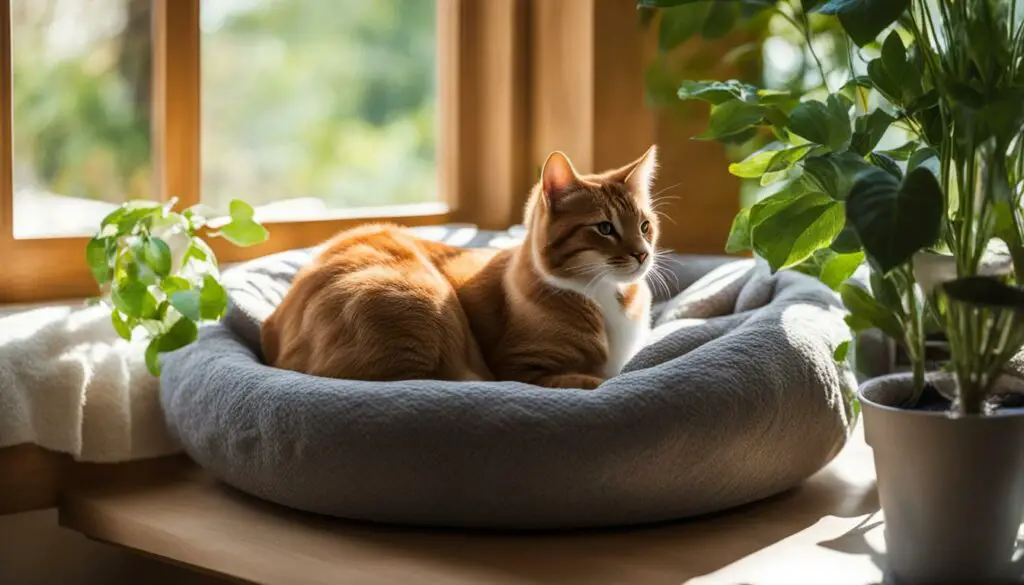
Is Your Cat Sleeping Too Much?
If you’ve noticed that your cat is sleeping for extended periods of time, you may be wondering if it’s normal or if there’s a cause for concern. Cats are known for their love of sleep, but excessive sleep could be a sign of underlying health issues. Let’s take a closer look at cat sleep duration, sleep schedule, and what is considered normal for our feline friends.
Normal Cat Sleep Duration
Cats are crepuscular animals, which means they are most active during dawn and dusk. However, they still spend a significant amount of time sleeping. On average, cats sleep for 15 to 20 hours a day, depending on their age, health, and activity level. Kittens and older cats tend to sleep more than adult cats. It’s important to understand that this is a natural behavior for cats and helps them conserve energy.
Signs of Excessive Sleep
While cats sleeping for long hours is normal, excessive sleep can be a cause for concern. If you notice that your cat is sleeping even more than usual, consistently sleeping all day without engaging in regular activities, it may be an indication of an underlying health issue. Other signs to watch out for include lethargy, loss of appetite, weight loss, or any changes in behavior. If you are unsure whether your cat’s sleep patterns are normal, it’s always best to consult with a veterinarian.
Establishing a Healthy Sleep Schedule
While cats naturally have their own sleep patterns, establishing a consistent sleep schedule can help maintain their overall well-being. Provide your cat with a quiet and comfortable sleeping area, away from disturbances. Engage your cat in regular play sessions during their active periods to encourage exercise and mental stimulation. If you notice any changes in your cat’s sleep schedule or excessive sleep that is accompanied by other concerning symptoms, it’s essential to seek veterinary advice.
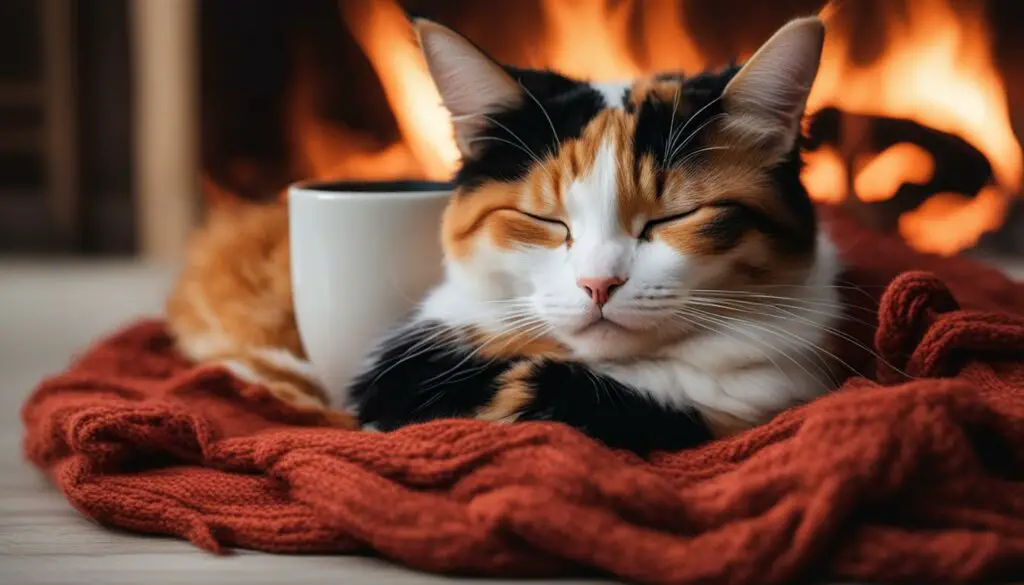
| Sleep Duration | Age Group |
|---|---|
| 15-20 hours | Kittens |
| 12-16 hours | Adult cats |
| 12-14 hours | Senior cats |
The Loaf: Understanding Your Cat’s Sleeping Position
One of the most common sleeping positions exhibited by cats is known as “the loaf.” This position involves a cat curling up with its legs tucked under its body, resembling a loaf of bread. While it may seem like a simple sleeping position, it actually holds some significance and insights into a cat’s behavior and comfort.
The loaf position is often a sign of comfort and relaxation for cats. By curling up tightly, cats can conserve body heat and create a cozy space for themselves. This position also helps them feel secure and protected, allowing them to rest deeply and peacefully. It’s a typical behavior seen in both domestic and wild cats, highlighting their innate instinct for finding safe and comfortable sleeping positions.
If you observe your cat sleeping in the loaf position, it indicates that they are content and at ease in their environment. It’s important to provide a comfortable sleeping area for your cat, with soft bedding and a warm temperature. Additionally, offering elevated areas or perches can further enhance their sense of security and provide additional sleeping options.
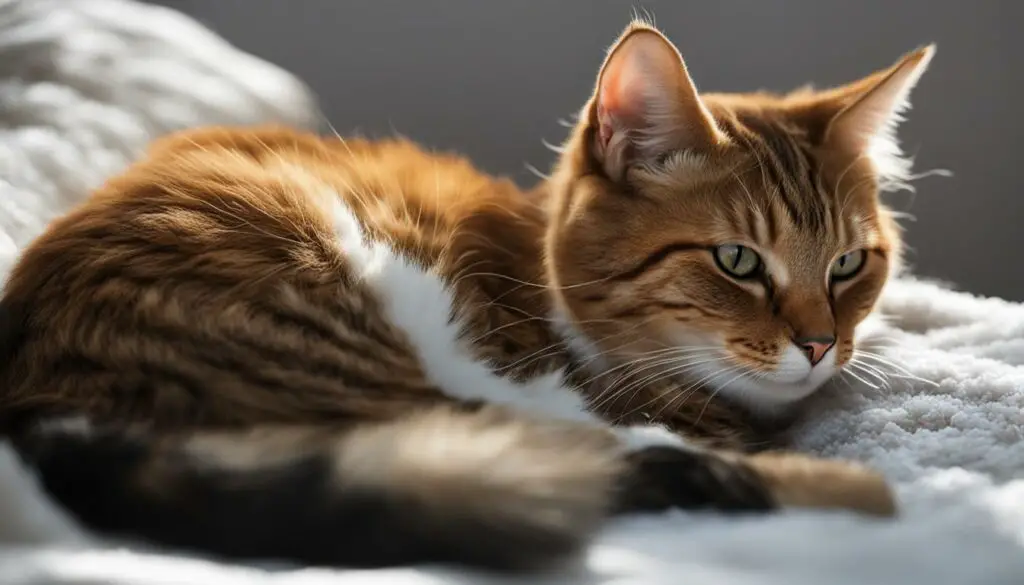
Benefits of the Loaf Position
| Benefits | Explanation |
|---|---|
| Conserves body heat | Cats can tuck their limbs close to their bodies, helping them retain warmth while they sleep. |
| Feeling secure | The curled-up position provides cats with a sense of safety and protection. |
| Comfortable and cozy | The loaf position allows cats to find a comfortable and snug sleeping spot. |
| Deep relaxation | When a cat feels comfortable and secure, it can enter a deeper state of relaxation during sleep. |
Understanding your cat’s sleeping positions can help you better meet their needs and create a conducive sleeping environment. By recognizing the loaf position and its significance, you can ensure that your feline companion is happy, comfortable, and getting the restful sleep they need.
Belly Up
When it comes to cat sleeping positions, one of the most adorable and endearing is when a cat sleeps on its back with its belly exposed. This position, known as the “belly up” position, is a sign of trust and contentment in cats. By exposing their vulnerable belly, cats are showing that they feel safe and comfortable in their environment.
This sleep position is a clear indication of the bond and trust between a cat and its owner. It’s a behavior that is reserved for moments of utmost relaxation and security. If you see your cat sleeping belly up, it means they have a deep sense of trust in you and feel completely at ease in your presence.
The belly up position is also a vulnerable sleep position for cats. In the wild, a cat would never sleep in this position unless it feels absolutely safe. By exposing their belly, cats become susceptible to potential attacks or harm. So, when your cat sleeps belly up, it’s a clear sign that they trust you to protect and care for them.
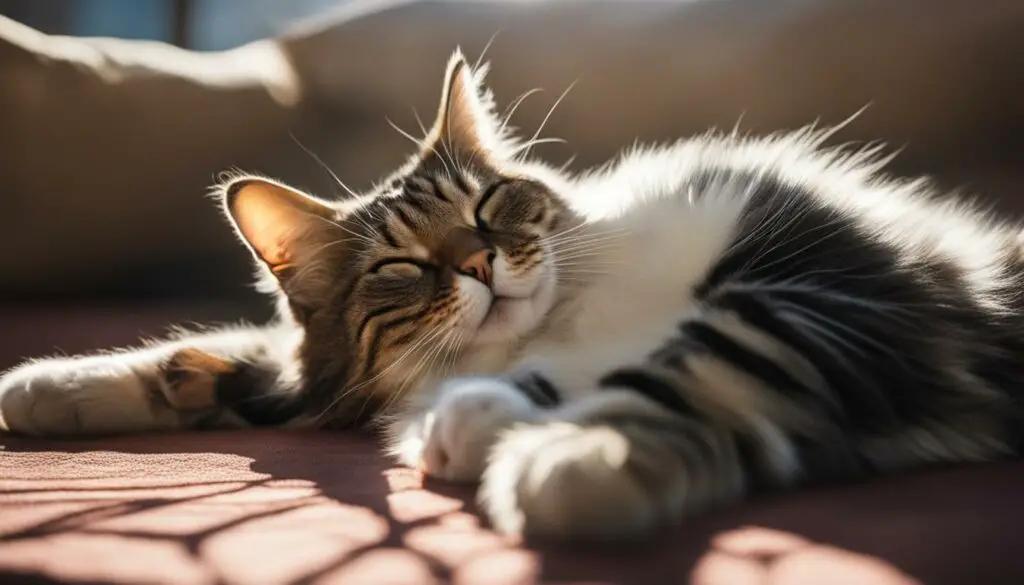
The Vulnerable Sleep Position of Cats
Sleeping belly up is not just a cute position, but it also has a physiological purpose. When cats sleep on their back, it allows them to stretch and relax their muscles fully. It’s their way of releasing tension and ensuring they get a deep and restful sleep. So, if you see your cat sleeping in this position, know that they are truly at peace and enjoying a peaceful slumber.
The Furry Ball
When it comes to cats and their instinctive sleep behavior, one common position you may observe is the “curled up in a ball” pose. In this position, the cat curls its body into a tight ball, tucking its head and tail in close. This position not only helps the cat conserve body heat but also provides a sense of security.
Cats are naturally drawn to warmth, and curling up in a ball allows them to retain heat more efficiently. By minimizing their surface area, cats can trap their body heat, which is especially beneficial in cooler environments or during the colder months.
| Sleep Position | Description |
|---|---|
| The Furry Ball | The cat curls up into a tight ball, tucking its head and tail in close. |
| The Loaf | The cat sits with its body curled up, head down, and possibly resting on its paws. |
| Belly Up | The cat sleeps on its back, exposing its belly, indicating trust and contentment. |
This instinctive sleep behavior can be traced back to the wild ancestors of domestic cats. Curling up in a ball allows cats to protect their vital organs, which are located in the abdomen, and helps them feel secure by minimizing their vulnerability to potential threats.
So, the next time you find your cat sleeping in a tight ball, you can rest assured that it’s a natural and instinctive behavior. Providing your cat with a warm and cozy sleeping environment will help them feel safe and comfortable, allowing them to fully enjoy their restful sleep.
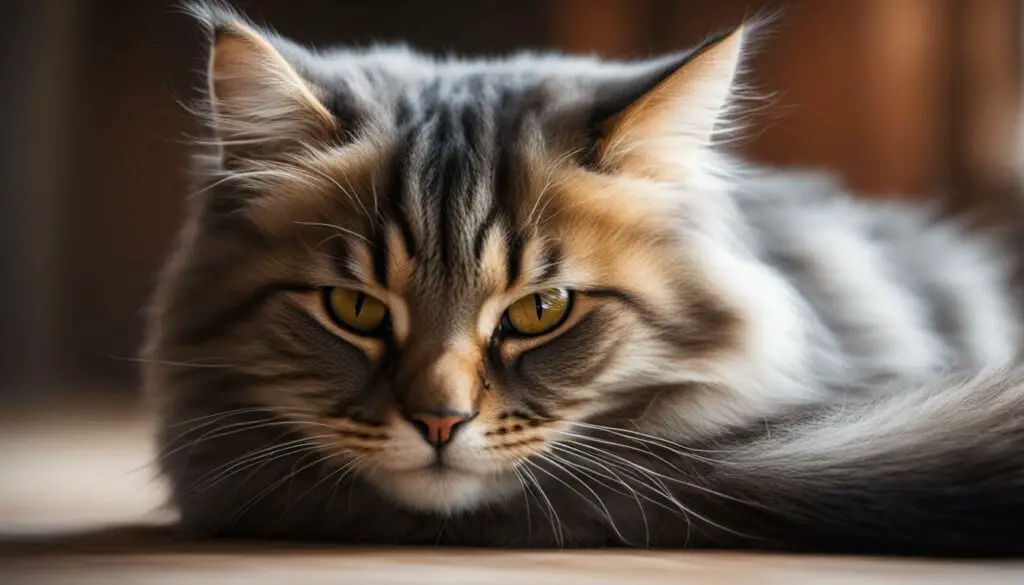
Be Careful Of Head Pressing In Cats
Cats are known for their peculiar behaviors, and one that cat owners should be especially cautious of is head pressing. Head pressing is when a cat continuously presses its head against a hard surface, such as a wall or furniture. This behavior is not to be confused with the normal sleeping position of cats with their head down. Head pressing can be a sign of potential neurological damage or underlying health issues that require immediate veterinary attention.
While head pressing may seem like an innocent behavior, it is actually a red flag that something may be seriously wrong with your cat. It can indicate neurological conditions such as brain tumors, infections, head trauma, or toxins. These conditions can cause inflammation, pressure, or damage to the brain, leading to abnormal behaviors like head pressing.
If you notice your cat engaging in head pressing, it is crucial to seek veterinary attention as soon as possible. Your veterinarian will perform a thorough examination and may recommend further diagnostic tests, such as bloodwork or imaging, to determine the underlying cause of the head pressing behavior. Early detection and treatment are essential in ensuring the best possible outcome for your cat’s health.
Head pressing in cats is not a behavior to ignore or dismiss. It is a clear indication that something is amiss in your cat’s health. If you observe your cat exhibiting head pressing behavior, do not delay in seeking veterinary care.
| Signs of Head Pressing in Cats | Possible Underlying Causes |
|---|---|
| Pressing head against objects | Neurological disorders |
| Lack of coordination | Brain tumors |
| Altered consciousness | Infections |
| Seizures | Head trauma |
| Changes in behavior | Toxins |
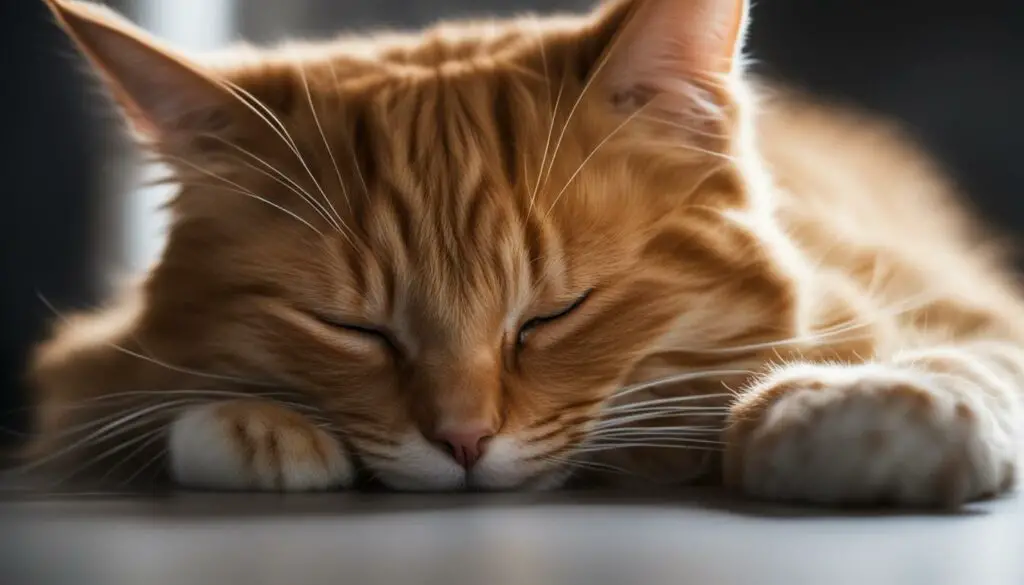
Remember, it is always better to err on the side of caution when it comes to your cat’s health. If you suspect any neurological issues or notice head pressing behavior in your cat, reach out to your veterinarian immediately. Your cat’s well-being and quality of life depend on early intervention and appropriate treatment.
Exploring Cat Pooping Behaviors And Health Risks
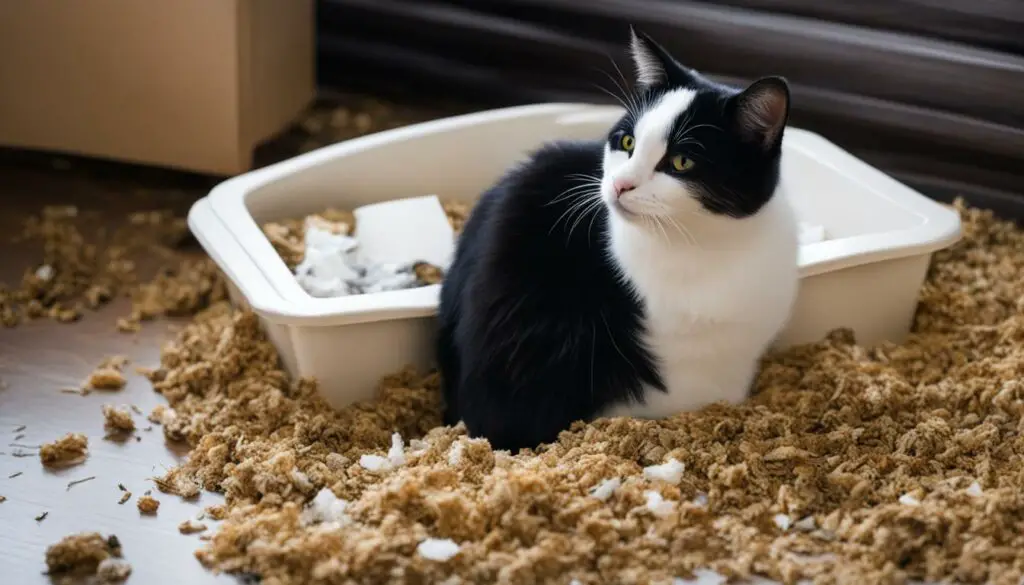
Understanding your cat’s pooping behavior is important for their overall health and well-being. Cats have unique preferences and habits when it comes to using the litter box, and changes in their pooping behavior can indicate potential health risks or problems. Here, we will delve into the various aspects of cat pooping behavior and the associated health risks.
Common Cat Pooping Positions
Cats may assume different positions when they poop, and these positions can reveal valuable insights into their health and comfort. Some common pooping positions include:
- Squatting: The most common position where the cat’s hind legs are bent, and they are balanced on their front paws.
- Standing: Some cats prefer to stand while pooping, which can be an indication of discomfort or difficulty in the litter box.
- Hunched posture: Cats that hunch their backs while pooping may be experiencing pain or digestive issues.
Health Problems Related to Cat Pooping
Changes in a cat’s pooping behavior can signal potential health problems. It’s essential to monitor your cat’s litter box habits to identify any red flags. Here are some health issues that may be associated with cat pooping behavior:
| Health Problem | Signs and Symptoms |
|---|---|
| Constipation | Infrequent or hard stools, straining in the litter box, decreased appetite |
| Diarrhea | Loose, watery stools, accidents outside the litter box, increased frequency of pooping |
| Urinary Tract Infection | Straining or crying while pooping, blood in urine, frequent urination |
| Blockage | Inability to poop, vomiting, loss of appetite |
If you notice any changes in your cat’s pooping behavior, such as straining, blood in the stool, or sudden litter box accidents, it’s crucial to consult with a veterinarian. They can determine the underlying cause and provide appropriate treatment options.
“Understanding your cat’s pooping behavior can help you detect potential health issues early on.”
Regular veterinary check-ups, a balanced diet, and providing a clean and easily accessible litter box can contribute to maintaining your cat’s digestive health. By paying attention to their pooping behavior and seeking prompt veterinary care when needed, you can ensure your cat’s well-being and prevent any potential health risks.
Conclusion
Understanding your cat’s sleep poses and behaviors can provide valuable insights into their needs, preferences, and overall well-being. Cats have a variety of sleeping positions, each with its own significance and meaning. From the classic loaf position and belly up pose to curling up in a furry ball, cats choose positions that offer them comfort, warmth, and a sense of security.
Creating a comfortable sleeping environment for your cat is essential. Ensure their sleeping area is warm, dark, and cozy, with options like a soft cat bed or elevated perches. Cats may choose to sleep face down to block out light and keep their noses warm. This position can also be a sign of trust and contentment, as cats expose their vulnerable bellies only when they feel safe.
While most sleeping positions are normal and healthy, it’s important to be aware of any changes or unusual behaviors. Sleeping excessively or in unusual positions could be a sign of an underlying health issue, such as arthritis or joint pain. Observing your cat’s sleeping patterns and consulting with a veterinarian when necessary ensures their overall health and well-being.
So, the next time you find your feline friend in a peculiar sleeping position, remember that it’s their way of expressing comfort, security, and even trust. Embrace their unique sleep poses and provide them with a cozy sleeping environment to keep them happy and well-rested.
FAQ
What is cat loafing with head down?
Cat loafing with head down is a unique sleeping position where a cat sits with its body curled up, head down, and possibly resting on its paws.
Why do cats sleep face down?
Cats may sleep face down because it’s a comfortable position that allows them to block out light and keep their noses warm. It can also make them feel safe and protected while they sleep.
Why do cats block out light when they sleep?
Cats have highly sensitive eyes, and sleeping face down helps them block out some of the light and create a darker sleeping environment. This is important for their natural hunting instincts at night.
Why do cats bury their noses when they sleep face down?
Cats have a higher body temperature than humans and rely on external sources of heat to stay warm. When they sleep face down, they may bury their noses in bedding or use their paws to keep their noses warm.
Is sleeping face down a personal preference for cats?
Yes, each cat has its own preferences for sleeping positions, and if a cat chooses to sleep face down, it indicates that they are comfortable and able to relax deeply during their sleep.
Why do cats sleep face down when they are tired?
Cats may choose to sleep face down when they are extremely tired as a way to quickly fall into a deep and restful sleep. However, it’s important to monitor their sleep patterns and make sure they are not excessively tired or lethargic.
Can sleeping face down be a sign of health issues?
Yes, older cats with arthritis or joint pain may find sleeping face down more comfortable. It’s important to observe any changes in your cat’s sleeping position or behavior and consult with a veterinarian if you suspect any health problems.
How can I create a comfortable sleeping environment for my cat?
You can create a comfortable sleeping environment for your cat by ensuring their sleeping area is warm, dark, and cozy. Providing a cat bed or tented cat bed can give them a sense of security and privacy. Elevated areas and high perches can also be appealing to cats for sleep.
How much do cats sleep?
Cats have natural sleep patterns and can sleep for 18-20 hours a day, which is normal behavior for them. However, if you notice excessive sleep and other signs of lethargy or loss of appetite, it may be a sign of underlying health issues.
What is the cat loaf position?
The cat loaf position is a common sleeping position where a cat curls up with its legs tucked under its body, resembling a loaf of bread. It’s a comfortable and secure position for cats.
Why do cats sleep on their backs with their bellies exposed?
Cats sleep on their backs with their bellies exposed when they feel safe and comfortable in their environment. It’s a behavior that indicates trust and contentment between the cat and its owner.
Why do cats curl up in a ball when they sleep?
Cats curl up in a ball when they sleep to conserve body heat, protect their vital organs, and create a cozy and secure spot for themselves. It’s a natural behavior seen in many animals, not just cats.
What is head pressing in cats?
Head pressing is when a cat continuously presses its head against a hard surface, indicating potential neurological damage or health issues. If you notice head pressing behavior in your cat, it’s important to seek veterinary attention.
How can cat pooping behaviors indicate health risks?
Cat pooping behaviors can indicate their health and well-being. Understanding normal pooping positions and being aware of any changes or issues can help identify potential health risks or problems.

